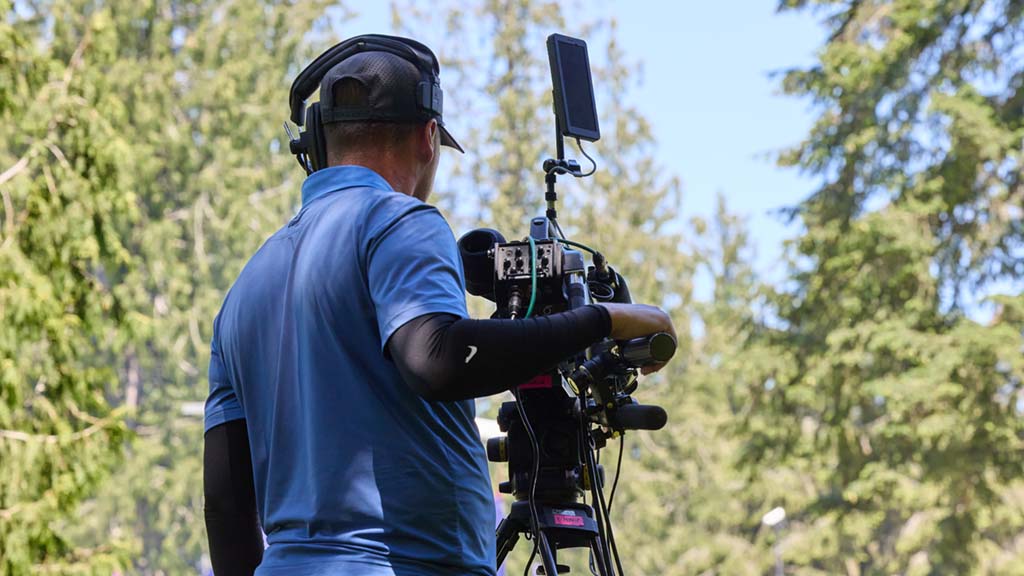Five Years Later, Has 5G Lived Up to Its Promise?
The high-speed connectivity standard continues to drive change in live production

It’s been five years now since the wireless carriers began rolling out 5G connectivity. Claims—sometimes exaggerated—about its possibilities were rampant then, including better steering of scalpels in robotic surgeries, downloading of HD feature-length movies in milliseconds, alleviating traffic jams and obsoleting human control of automobiles.
Not all of these glowing promises have come to fruition, and only time will tell if they ever will. One thing about 5G is certain, though, and that’s its much-less-hyped impact on TV broadcasters and content producers. Although bonded-cellular video transmission arrived a decade ahead of 5G’s rollout and has done a lot in terms of freeing remote telecasts from conventional connectivity, broadcasters—in general—agree that this fifth iteration of wireless broadband is living up to the promises that accompanied it.
What It Brings to the Table
“We have spoken for several years now about the impact that 5G has made to bonded cellular,” said Dan Pisarski, chief technology officer at LiveU. “A key example is what is called ‘deterministic latency,’ where the changes in the in-air protocol called ‘New Radio,’ or ‘NR,’ in 5G, use a much more fixed latency compared to LTE [long term evolution, a term used to describe earlier broadband wireless technology].
Pisarski observed that 5G’s utilization of new spectrum allocations provides “a much more complete workflow for users,” allowing such enhancements as two-way intercom capability, video return feeds, robotic camera control and more.
“This ensures that a team deployed with a LiveU unit is a full-capability remote team, communicating, reviewing and interacting with remote management—not just ‘shooting video,’ ” he said.
A notable example of how 5G is impacting live sports coverage happened last summer when NBC Sports was able to add more 5G cameras to more holes at Sahalee Country Club in Sammamish, Washington, site of the 2024 KPMG Women’s PGA Championship. This was due to the scalability of T-Mobile’s 5G portable private network, according to Chris Melus, vice president of product management at T-Mobile’s Business Group.

“Broadcasters loved that they could get super-fast, fiber-like speeds without the wires,” he said, adding that 5G can provide “glass-to-glass latency that averages under 100 milliseconds, enabling full-4K 60 fps resolution.”
The professional video industry's #1 source for news, trends and product and tech information. Sign up below.
As an added bonus at the tourney, T-Mobile also rolled out another 5G-based enhancement for spectators in the form of real-time player data delivered to smartphones. The app provided such information as radar trajectory of golf shots, 3D imagery, views of greens and more. “Broadcasters have found tremendous value in the ability to integrate 5G into their remote production suite of tools because of 5G’s ability to efficiently bring fans more high-quality content without the burden of wires,” Melus added.
5G at the Olympics
5G also made a big splash at the Paris Summer Olympics, allowing broadcasters to provide coverage of events in ways that would not have been possible previously, and taking both in-person and video spectator enjoyment to new heights.
5G was key for France.tv to be able to cover the torch relay across 1,600 kilometers (about 1,000 miles) of France from May to July, according to Matt McEwen, vice president of product at TVU Networks.
“In the past, a large-scale moving event like this would have required helicopters and planes to receive and relay the video signals being captured by the mobile cameras,” he said. “Utilizing both public and private 5G infrastructure allowed France.tv to transmit the mobile signal without aerial support, saving 92% of the typical costs. If such a workflow were not possible, France.tv simply would not have been able to produce nine weeks of live torch relay coverage due to budget constraints.”
“5G has absolutely transformed how we now cover large-scale events like the Summer Games in Paris,” said Sukhvir Grewal, sales account manager at Dejero. “These events demand real-time, high-quality coverage from multiple locations and angles. With 5G’s higher bandwidth and lower latency it’s possible to deliver a better viewer experience even more seamlessly.”
In recalling coverage of the event’s opening ceremonies, which took place along a 6-kilometer (about 4-mile) portion of the River Seine, Jim Jachetta, chief technology officer at VidOvation, observed that 5G made all the difference in capturing close-up footage of athletes aboard the scores of boats.
“Olympic Broadcasting Services, in partnership with Haivision, utilized over 200 Samsung S24 Ultra smartphones equipped with Haivision’s MoJoPro mobile camera apps … [to provide] HDR video feeds via a dedicated 5G network supported by 12 5G cells mounted on bridges,” he said.
Jachetta added that history was made in coverage of another water event, the Marseille sailing competitions. “A standout achievement was the creation of the world’s first sea-based private 5G network,” said Jachetta. “This network, which featured 5G antennas on large catamarans, enabled live video transmission from rapidly moving boats. The 5G network’s flexibility allowed it to adapt to various sailing courses, ensuring uninterrupted coverage of the sailing events regardless of the boats’ location.”
Is It Really All That?
Since its introduction, bonded cellular has been quietly displacing conventional microwave and satellite links to deliver news and other live feeds. When the first bonded-cellular gear appeared, 4G (with anticipated data rates of perhaps 100 Mbps), was just beginning to roll out, and 3G with its low Mbps (or even high Kbps) throughput was still the norm.
Fast forward to 2024 and the availability of 5G networks across most of the United States has greatly expanded, with about 60% of the population within the reach of a 5G signal. We asked several broadcasters if it was really making a difference in their field operations. The answers were something of a mixed bag.
“I can’t say I’ve noticed a difference between 4G and 5G,” said Pete Sockett, Capitol Broadcasting’s director of engineering and operations, who is based in the Raleigh-Durham, North Carolina, area. “It may have helped some with connectivity, but it’s hard to say.”
Since we switched to 5G, we’re able to get shots that we could never get before.”
Dan Wilson, WPSD-TV
Dan Wilson, chief engineer at WPSD-TV Paducah, Kentucky, had a different response. “Since we switched to 5G, we’re able to get shots that we could never get before,” he said. “With 5G it’s even better and easier to get shots. Before 5G, the shots might pixelate and a reliable transmission was ‘iffy.’ Once 5G hit, that went away.”
Wilson noted that his station was still getting used to 5G, as it’s only been available in the Paducah area for the past half-year or so. He also commented on the impact 5G’s reduced latency was having on WPSD’s remote operations.
“The low latency is even better than I thought possible,” he added. “We’d gotten accustomed to a minimum three-second delay. Now it’s a second-and-a-half or even just a second. This has gotten us almost back to analog microwave days in terms of delay. It’s a real game-changer.”
David Ostmo, San Antonio, Texas-based regional engineering director for Sinclair Broadcast Group, noted that while 5G has perhaps increased the comfort level in bringing in remotes via bonded cellular, it hasn’t been a complete panacea.
“We were making pretty extensive use of LiveU technology prior to the 5G rollout,” said Ostmo. “It may be a little more comfortable trusting a football game to 5G than to 4G. We’re always concerned about a secondary link with microwave or satellite at an important event. We’ve lost live shots at large events using only bonded cellular. There was a strong signal when we were testing, but then the video was poor with pixelation when we went on the air.”
He noted that in this respect, 5G has made things better. “Where it is available, we get a more robust connection and better throughput,” he said, adding that 5G was also enabling more elaborate field productions than could be undertaken before its deployment.
What About Trucks?
Ostmo noted also that while his organization had eliminated some of its conventional microwave and satellite trucks, he felt that it was important to retain a backup to cellular, despite the claims made for 5G. “We need the ability to broadcast after a large natural disaster such as a hurricane or tornado, and cellular networks could be destroyed,” he said. “This is especially in tornado- or hurricane-prone areas.”
Ostmo observed that as microwave or satellite trucks “age out” and are retired, there will always be a need for microwave and two-way radio linkage from the field that’s independent of common carriers.
Perhaps the biggest problem with 5G right now, according to Ostmo—whose responsibility extends over Sinclair stations spread over several states in the south-central portion of the U.S.—is lack of solid coverage.
“Where it’s available, we get a more robust connection and better throughput,” he said. “But it’s not available everywhere. In San Antonio, there’s good coverage in the city and not-so-good coverage as you go further out. There’s not any advantage in Nebraska.”
James E. O’Neal has more than 50 years of experience in the broadcast arena, serving for nearly 37 years as a television broadcast engineer and, following his retirement from that field in 2005, moving into journalism as technology editor for TV Technology for almost the next decade. He continues to provide content for this publication, as well as sister publication Radio World, and others. He authored the chapter on HF shortwave radio for the 11th Edition of the NAB Engineering Handbook, and serves as contributing editor of the IEEE’s Broadcast Technology publication, and as associate editor of the SMPTE Motion Imaging Journal. He is a SMPTE Life Fellow, and a member of the SBE and Life Senior Member of the IEEE.

